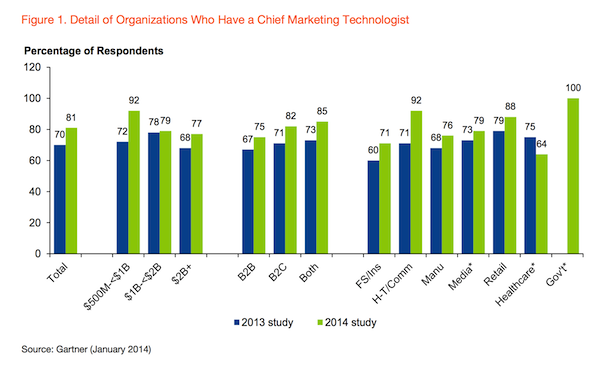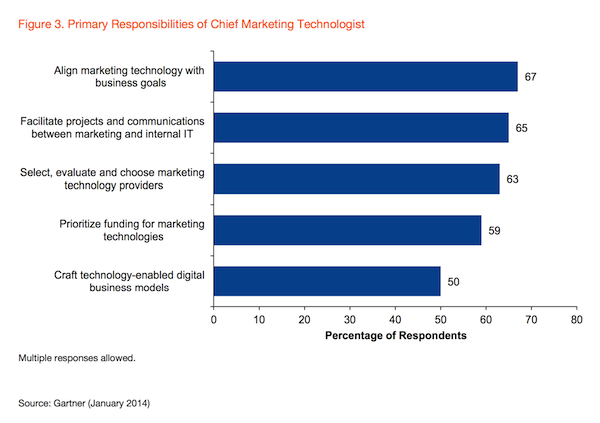
Looking at the latest marketing technology landscape, you might ask yourself, “How the heck do marketers make sense of all of this?”
Increasingly, the answer is: they have a chief marketing technologist.
A terrific new research report by Laura McLellan of Gartner, How the Presence of a Chief Marketing Technologist Impacts Marketing, confirms that this senior hybrid role — “part strategist, part creative and part technologist” and “broadly the equivalent of a CTO and a CIO dedicated to marketing”— is growing in popularity.
Within large companies — more than $500 million in annual revenue — 81% of them now have a chief marketing technologist role, up from 71% just a year ago. Another 8% expect to add that role within the next 24 months.
Why?
“Every aspect of marketing — from brand, experience design and demand generation, to content marketing, analytics and measurement — is affected by technology,” the report states. “The CMO needs a senior trusted advisor skilled in the art of evaluating and implementing technology-enabled solutions.”
The CMO needs a senior trusted advisor skilled in the art of evaluating and implementing technology-enabled solutions.
In the 285 companies that Gartner studied, 71% have the chief marketing technologist role report directly to a senior marketing executive. The remaining 29% have the role report to IT. Either can work, but Gartner recommends: “Ideally this position is solid line to marketing, whether the most senior marketing executive, brand or line of business marketing, or regional marketing.”
Of course, there are many variations in titles for this role — the most recent one I’ve heard is SAP’s “business information officer” (BIO) role. But the primary responsibilities are all very similar, with the #1 mission being to align marketing technology with business goals:

According to Gartner, they help senior marketing executives answer questions such as:
- Who is leading the charge, deciding which technologies to adopt, how they are implemented and at what pace?
- Even after they are integrated, who will manage their ongoing evolution?
- Which marketing technology projects should be done in-house, and which through external marketing service providers?
What effect do chief marketing technologists have on organizations? Expanding their research this year, Gartner found several powerful correlations among those that have someone in that role compared with those who don’t:
- They will spend 11.7% of their revenue on marketing, compared with 7.1% for those who don’t.
- They will spend 30% of their marketing budget on digital marketing, compared with 21% for those who don’t.
- They will spend 9.8% of their marketing budget on innovation, compared with 5.0% for those who don’t.
While correlation is not causation, it’s hard not to see the pattern: companies with marketing technology leadership are investing much more than their peers in marketing — particularly digital marketing — to engage with their customers. If you put your money where your strategy is, these companies clearly view marketing more strategically.
Even more interesting, they’re spending nearly 2X as much on innovation in marketing, which includes pilot projects and experimentation with new technologies and techniques. 92% of the companies that have a chief marketing technologist have allocated money from their marketing budget for innovation — as compared to 43% for those who don’t.
Gartner concludes their report:
“If you don’t have a chief marketing technologist, consider the evidence above and strongly evaluate the benefits of creating the role; increasingly only exceptional cases will be able to argue that they don’t need one.”
As you might imagine, I enthusiastically agree.




Clearly, this function is growing in enterprise contributory value. Gartner’s perspective is spot-on, with this one caveat: It’s not just the CMO who needs a senior trusted analytical advisor. In this era of big data and predicative modeling sophistication, the entire company will benefit from having a chief marketing (and customer-related data) technologist.
HOW MUCH MARKETING TECHNOLOGY IS ENOUGH?
Hi Scott
I have been saying something similar to my banking, telco and automotive clients for some time. The Chief Marketing Technologist is a critical role as marketing becomes more and more technology-driven.
But there is a larger and more important question that you don’t ask: Exactly how much technology does marketing need to optimise business value? Just implementing more and more marketing technology obviously can’t be the answer. And a subsidiary question: How do you implement technology so that it catalyses marketing transformation?
The sad fact is that many implementations of marketing technology don’t create the business value expected of them, let alone catalyse marketing transformation. Just buying and implementing marketing technology without pulling all the other levers required to create business value and catalyse transformational change is a recipe for failure. The high early failure rates of technology-driven change projects like ERP, BPR, CRM and now marketing technologies like MRM, all illustrate the general principle…
OO + NT = EOO
Old Organisation + New Technology = Expensive Old Organisation
Data gathered directing transformational change programmes in major corporations over the past 25 years suggests that technology is tyically responsible for approx 15% of the available value from a transformational change programe. Planning is worth 20%, processes 20%, mesurement 20% and people the final 25%. The more all these levers are pulled in a coherent, integrated way the higher the business value a marketing technology programme will create and the higher the likelihood that it will transform the organisation.
Unfortunately, just implementing technology by itself won’t even produce the 15% of value potentially available from the technology. Transformation change project returns follow an approximate (field) hockey stick shaped curve. Piece-meal implementation, e.g. of just technology, creates a lot of costs but doesn’t pull enough of the other levers for enough people to generate any net value. It is only when more of the levers are pulled and more people are affected (research suggests approx. 40-50% of people) that the value start to outweight the costs and the net value start to climb the handle of the hockey stick.
There is enough research into project failure reasons, complementary capabilities and phase changes in transformation projects to validate all three points. And all of them point to the inexorable fact that…
OO + NT Really Does = EOO.
So back to my original question: Exactly how much technology does marketing need to optimise business value?
Graham Hill
@grahamhill